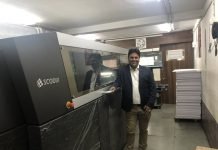Investing in new technology is one of the most important decisions a business faces when considering how to improve their operations. According to Kodak, printers who switched to Kodak Sonora Process Free Plates are delivering greater operational efficiencies and return on investment (ROI).
To help printers who are considering changing their plates to process free, Kodak has developed the Sonora Plate Savings Estimator. This new online tool allows printers to calculate their estimated savings if they were to switch from a traditionally processed plate to Kodak Sonora Process Free Plates.
“More than 4000 printers around the world have made the switch to Sonora Process Free Plates. They are saving money, time and are reducing their impact on the environment,” said Evandro Matteucci, vice president, Print Systems Division, Eastman Kodak. “We understand it might be costly for printers to change some of their business practices or swap out inefficient equipment. Switching plates is a quick and easy way to start saving money and to take a step toward becoming more sustainable. The Savings Estimator takes the guesswork out when making that decision.”
Traditional plate processing uses water, energy, and chemicals to prepare plates for the press after imaging on the CtP device. The processing step also adds variability that impacts efficiency and costs in the pressroom. The Sonora Plate Savings Estimator provides a customized calculation of the savings a printer could see if they integrate Sonora Plates into their operations. To calculate the savings, printers simply enter information about their current plate volumes, type of plate processing used, plate price, and the location of their business. The Savings Estimator will then instantly calculate the total estimated savings for several local currencies.
In addition to using the Savings Estimator, printers can also contact their local sales
representative by visiting here to request a comprehensive calculation based on the individual company’s specific processes, costs, and equipment. Aside from reducing energy, water and chemistry costs, Sonora Process Free Plates can free up space by eliminating processing equipment, eliminate the variability from processing to improve consistency and quality, get plates to press faster, particularly with plate remakes, reduce maintenance costs and downtime with less equipment, provide a cleaner, safer working environment and reduce environmental impact.
Kodak’s continued investment to advance its process free technology resulted in the introduction of the Sonora X Process Free Plate. With Sonora X Plates, up to 80% of printers can now switch to process free plates, including large printers and those printing challenging applications that need a high-performance plate. Sonora X Plates deliver three significant improvements over Sonora XP Plates, including longer run lengths, especially with UV applications, faster imaging speeds, and more robust handling capabilities. As the adoption of Kodak Sonora Process Free Plates has accelerated around the globe, Kodak expects nearly one out of three plates it sells to be process-free by the end of 2019.
















